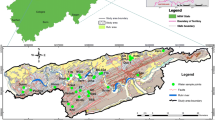Abstract.
The Lexington tunnel is the last accessible underground mine working in the Butte, Montana mining district. Used as recently as 1993, the tunnel and adjacent workings have been abandoned for over 10 years. Although the Lexington tunnel is over 200 m above the regional water table, perched water is present over much of its extent. Mine water near the portal is moderately acidic (pH 4 to 5), with extremely high concentrations of metals, including Cu (up to 1000 mg/L) and Zn (up to 1400 mg/L). In the middle reaches of the tunnel, the quality of the water is much better, with near-neutral pH, high bicarbonate alkalinity, and lower concentrations of heavy metals. The low acidity and metal content is attributed to a lack of pyrite and other sulfides in this portion of the mine, as well as the presence of carbonate minerals, such as rhodochrosite (MnCO3), in exposed veins. Sulfide minerals are more widespread further back in the tunnel, and are now oxidizing rapidly, leading to pockets of severe acid drainage (pH< 3, dissolved Zn up to 5000 mg/L).
Geochemical modeling suggests that the near-neutral waters—the most voluminous type encountered in the Lexington tunnel—are close to equilibrium saturation with rhodochrosite and hydrous Zn-carbonate (ZnCO3•H2O). The Eh of these waters is most likely controlled by redox reactions involving dissolved Mn2+ and secondary, Zn-rich, hydrous Mn-oxides. In contrast, the Eh of the acidic waters appears to be controlled by reactions involving Fe2+ and Fe3+. Most of the acidic waters are saturated with K-jarosite, which forms delicate, straw-like dripstones at several localities. Decaying mine timbers could be an important renewable source of organic carbon for heterotrophic microorganisms, such as iron- and sulfate-reducing bacteria, especially deeper in the mine workings where the ground is saturated with anoxic ground water.
Similar content being viewed by others
Author information
Authors and Affiliations
Corresponding author
Rights and permissions
About this article
Cite this article
Gammons, C.H. Geochemistry of Perched Water in an Abandoned Underground Mine, Butte, Montana. Mine Water Environ 25, 114–123 (2006). https://doi.org/10.1007/s10230-006-0119-1
Received:
Accepted:
Issue Date:
DOI: https://doi.org/10.1007/s10230-006-0119-1




